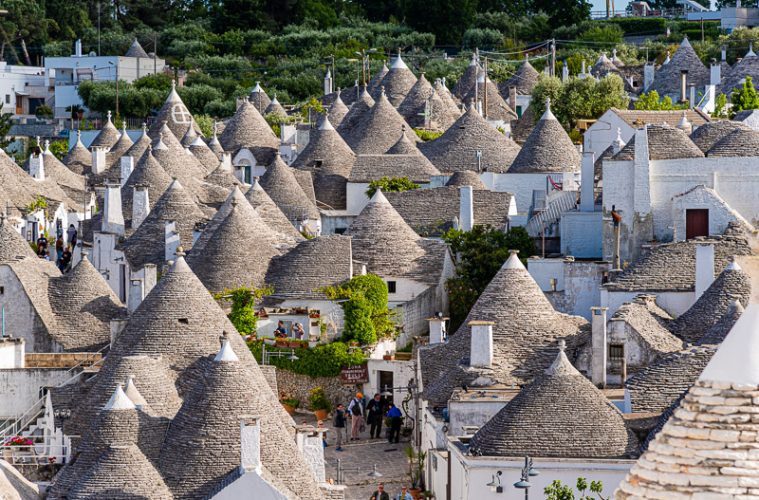ALBOREBELLO’S JIGSAW ROOFED HOMES
The twin of Şanlıurfa’s most unique symbol Harran, resides roughly 2500 kilometers away from it. Connected to the city of Bari at the heel of the boot that is Italy, the small town called Alberobello is known by its conically roofed houses called “Trulli”, a spitting image of Harran.

You might have a hard time pronouncing the name Alborebello, reminiscent of a tongue twister; meaning “beautiful tree”. It is difficult even, to find this tiny settlement on the map. However, if you are determined enough to make the trip; you won’t be leaving empty handed. You are in a place that made it to UNESCO’s World Heritage List by its own right after all.
It’s history tracing back to 14th century, Alborebello resembles the Smurf’s village at first glance. The conically roofed white stone structures that resemble mushrooms serve various purposes; such as homes, souvenir shops, restaurants and lodges. But their reason of construction wasn’t tourist attraction to begin with.
The Way to Avoid Taxes: A Jigsaw Roof!
It is rumored that the rationale behind this architecture is taxes. Yes, you have read that right, taxes! The king of the time had banned building houses without his approval, and demanded that high taxes be taken from the pre-existing ones. Thus, the folk devised a solution by building jigsaw homes by piling small lime stones on top of eachother without grout. Since conically shaped structures or structures without grout and a roof did not qualify as housing; they would dodge the tax by demolishing the roof when the tax officer came and rebuilding it upon his departure. In other words, a brand new architectural approach was born out of desperation.
In houses of Trulli, the walls and roofs rising from the spiral foundation are made from small lime stones extracted from the same area by stacking them without grout. The area which is set on a carstic terrain allowed for buildings to use lime stone as a main material, and to be demolished and rebuilt with relative ease. To rebuild demolish roofs might sound intimidating but this was way more feasible than paying the taxes for the local community that mostly made a living by agriculture.
“Smart” Homes
Indurable to corrosion and easily soluble carstic lands provided another advantage to the locals: The water beds carved out by winter rains created streams that flow towards the Adriatic. The locals built a lot of cisterns to incorporate water accessibility to their lives. Each Trulli home has a reservoir that provides the home’s water supply. Therefore we are facing pretty much self-sufficient and sustainable settlements. The rocks that were extracted whilst digging the reservoirs were repurposed to build the walls. Surely, this is what we mean when we say “efficient use of resources”. Needless to say, the stone walls of these picturesque homes provide insulation; keeping it cool in the summers and warm in winters. Each of these are efficient, “smart” homes. In other words, the folk of Alborebello blazed the trail of recycling and sustainability ages ago, and inadvertently at that.
The Enchanted Look That Comes With Stone
What’s more is the fabulous look of the Trulli homes lined up in adjacent order. Some of these were turned into big homes with living rooms, bedrooms and bathrooms via interconnections. The ungrouted Trulli homes are white and grey. There are more than 1500 of them in the village today, far more than the initial 40. When observed carefully, different symbols can be seen on the roofs. These can be the symbol of the architect of the house, or simply symbols of meaning for the inhabitants.
Alborebello which was taken into the UNESCO’s World Heritage list in 1996 is a touristic heaven to its fullest extent, with its adorable cafes, restaurants and souvenir shops. Some homes are used as hotels and lodges. This cute village with its population of 11 thousand is also known for its olive oil.
Are Your Homes “Smart” and “Beautiful”?
Whilst you made it that far, don’t hesitate to fetch a bottle of that famous olive oil. But what about leaving Alborebello with something way more permanent? Perhaps a piece of the centuries old wisdom of the locals? It isn’t that difficult to add this fable-like touch in your very own home, garden, summer house or office. What’s more is that you needn’t demolish what you have built if the taxman arrives! All you need for a “smart” and “beautiful” living space is within hand’s reach:
https://www.stonewrap.com/en/products

